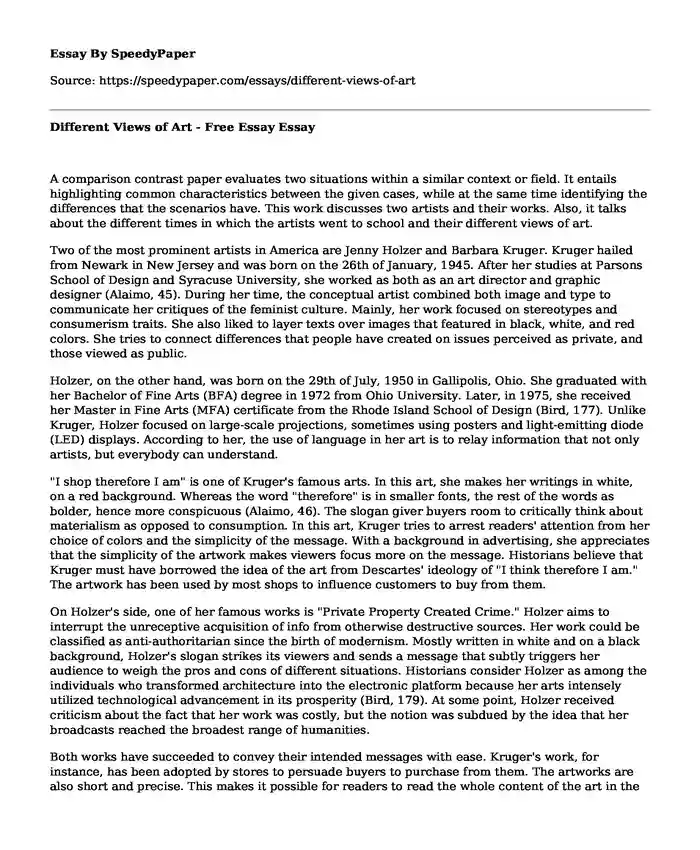
| Type of paper: | Article |
| Categories: | Inspiration Arts |
| Pages: | 3 |
| Wordcount: | 819 words |
A comparison contrast paper evaluates two situations within a similar context or field. It entails highlighting common characteristics between the given cases, while at the same time identifying the differences that the scenarios have. This work discusses two artists and their works. Also, it talks about the different times in which the artists went to school and their different views of art.
Two of the most prominent artists in America are Jenny Holzer and Barbara Kruger. Kruger hailed from Newark in New Jersey and was born on the 26th of January, 1945. After her studies at Parsons School of Design and Syracuse University, she worked as both as an art director and graphic designer (Alaimo, 45). During her time, the conceptual artist combined both image and type to communicate her critiques of the feminist culture. Mainly, her work focused on stereotypes and consumerism traits. She also liked to layer texts over images that featured in black, white, and red colors. She tries to connect differences that people have created on issues perceived as private, and those viewed as public.
Holzer, on the other hand, was born on the 29th of July, 1950 in Gallipolis, Ohio. She graduated with her Bachelor of Fine Arts (BFA) degree in 1972 from Ohio University. Later, in 1975, she received her Master in Fine Arts (MFA) certificate from the Rhode Island School of Design (Bird, 177). Unlike Kruger, Holzer focused on large-scale projections, sometimes using posters and light-emitting diode (LED) displays. According to her, the use of language in her art is to relay information that not only artists, but everybody can understand.
"I shop therefore I am" is one of Kruger's famous arts. In this art, she makes her writings in white, on a red background. Whereas the word "therefore" is in smaller fonts, the rest of the words as bolder, hence more conspicuous (Alaimo, 46). The slogan giver buyers room to critically think about materialism as opposed to consumption. In this art, Kruger tries to arrest readers' attention from her choice of colors and the simplicity of the message. With a background in advertising, she appreciates that the simplicity of the artwork makes viewers focus more on the message. Historians believe that Kruger must have borrowed the idea of the art from Descartes' ideology of "I think therefore I am." The artwork has been used by most shops to influence customers to buy from them.
On Holzer's side, one of her famous works is "Private Property Created Crime." Holzer aims to interrupt the unreceptive acquisition of info from otherwise destructive sources. Her work could be classified as anti-authoritarian since the birth of modernism. Mostly written in white and on a black background, Holzer's slogan strikes its viewers and sends a message that subtly triggers her audience to weigh the pros and cons of different situations. Historians consider Holzer as among the individuals who transformed architecture into the electronic platform because her arts intensely utilized technological advancement in its prosperity (Bird, 179). At some point, Holzer received criticism about the fact that her work was costly, but the notion was subdued by the idea that her broadcasts reached the broadest range of humanities.
Both works have succeeded to convey their intended messages with ease. Kruger's work, for instance, has been adopted by stores to persuade buyers to purchase from them. The artworks are also short and precise. This makes it possible for readers to read the whole content of the art in the least time, possibly at a glance of it. Colors used are also attractive to human attention, hence assuming them is relatively tricky (Alaimo, 48). As a result, the massages that both artists convey reaches the higher number of audience. Both works also call upon good morals in society, and a peaceful co-existence. They encourage a particular behavior in people that either enhances their view on a specific idea.
Despite the similarities, Kruger seems to have been more successful than Holzer in their works. Ideally, having been printed mainly on shopping bags, "I shop therefore I am" reaches a wider audience since the shoppers carry the bags around town and home, thereby promoting the extent to which the message printed is propelled. Holzer's "Private Property Created Crime" on the other hand is stationary, and only reaches audiences in the specific area. Also, the customers might not notice the message since it is raised high above eye level - however, the use of LED assists to draw people's attention. Also, "I shop therefore I am" encourages people on a trend of buying. "Private Property Created Crime" however discourages people from scrambling over property and privatizing them. Instead, a property should be publicly or communally owned, to ensure that members of society reasonably enjoy the services of any available resources.
Works Cited
Alaimo, Stacy. "Material Feminism in the Anthropocene." A Feminist Companion to the Posthumanities. Springer, Cham, 2018. 45-54.
Bird, Jon. "Under Erasure: Jenny Holzer's War Paintings." Journal of Contemporary Painting 3.1-2 (2017): 177-193.
Cite this page
Different Views of Art - Free Essay. (2022, Oct 31). Retrieved from https://speedypaper.net/essays/different-views-of-art
Request Removal
If you are the original author of this essay and no longer wish to have it published on the SpeedyPaper website, please click below to request its removal:
- Free Essay with the Fusion Centers Research
- Career Goals Essay Example
- Free Paper with a Review of the Financial Statements of Utah Symphony and Opera
- Essay Sample Describing Three Arms of Government
- Free Essay on Leadership Development in Colleges and Universities
- Free Essay: Mental Health a Major Concern Among the Youth Today
- Free Essay Example - Antonio Canova
Popular categories




